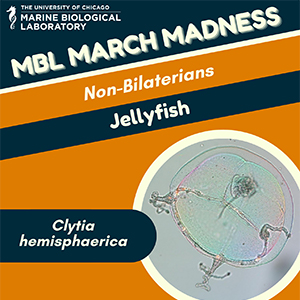MBL March Madness: Jellyfish


The adult medusa phase of Clytia hemisphaerica is an excellent model for studying wound healing and regeneration in epithelial (skin) cells. Epithelial cells form a simple monolayer on the upper surface of the medusa. These cells can be gently scratched to create a wound. The transparency of the system makes it ideal for imaging and scientists can observe how wounds heal in real time.
Cool facts
- A Clytia medusa cut in half will become two smaller medusae.
- Many of the organs can act autonomously. For example, the mouth can live and flourish after it’s removed from the animal, isolated gonads still release eggs, and a tentacle can still grab a shrimp after it has fallen off.
- Clytia can heal wounds in its epithelium at least an order of magnitude faster than any other system reported in the literature.
(ID Card Photo Credit: Elizabeth Lee | Equipment: Leica DMR equipped with a Zeiss axiocam 506 mono 10x objective)
Select Publications
Gemmell BJ, Colin SP, Costello JH and Dabiri JO (2015) Suction-based propulsion as a basis for efficient animal swimming. Nature Communications: doi.org/10.1038/ncomms9790
Houliston E, Momose T, Manuel M. (2010)Clytia hemisphaerica: a jellyfish cousin joins the laboratory. Trends in Genetics. doi.org/10.1016/j.tig.2010.01.008
Fourrage, C. et al. (2014) An endogenous green fluorescent protein–photoprotein pair in Clytia hemisphaerica eggs shows co-targeting to mitochondria and efficient bioluminescence energy transfer. Open Biology. doi.org/10.1098/rsob.130206
Kamran Z, et al. (2017) In vivo imaging of epithelial wound healing in the cnidarian Clytia hemisphaerica demonstrates early evolution of purse string and cell crawling closure mechanisms. BMC Dev Biol. doi.org/10.1186/s12861-017-0160-2
Sinigaglia C, Peron S, Eichelbrenner J, Chevalier S, Steger J, Barreau C, Houliston E, Leclère L. (2020) Pattern regulation in a regenerating jellyfish. Elife. doi.org/10.7554/eLife.54868
Division: Non-Bilateria
While bilaterian animals have a distinct front, back, top, and bottom, non-bilaterian organisms lack that symmetry. Non-bilaterian animals include sponges, jellyfish, corals, comb jellies, sea anemones, and placazoa (simple, free-floating multicellular marine organisms). Learn more about the Non-Bilaterian Division.
Meet the Other Non-Bilaterian Organisms
-
- Northern Star Coral (Astrangia poculata)
- Comb Jelly (Mnemiopsis leidyi)
- Stentor (Stentor coeruleus)
What is MBL March Madness?
Based on the March Madness NCAA basketball tournament, during MBL March Madness, popular MBL organisms face off for your votes. YOU have the opportunity to decide what organism is crowned victorious by voting for your favorite organisms in a series of head-to-head match-ups. Voting will take place on the MBL social media channels from March 29 - April 7. Learn more and download a bracket at mbl.edu/march-madness.